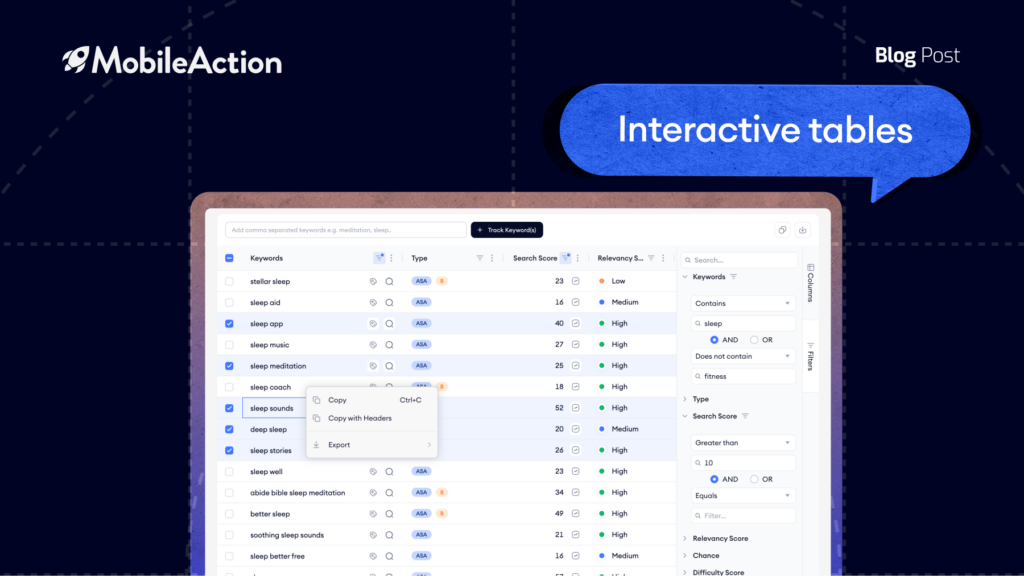In the ever-evolving landscape of app development and user experience, understanding your users’ sentiments and preferences is paramount to success. This is where in-app feedback emerges as a vital tool for app developers and businesses.
The process of actively seeking and collecting feedback from users while they engage with your app can yield plenty of benefits, such as enhancing retention rates, getting immediate insight on a new feature, providing robust customer support, and getting positive reviews and rankings in app stores.
To better understand and implement the feedback, ratings, and reviews, MobileAction developed App Intelligence. You can use this tool to check the breakdown of reviews, download counts, revenue projections, and the most recent reviews, respond to these reviews on MobileAction, and track changes in your app’s category ranking across several storefronts for the date you specify. They enable you to manage your brand more effectively on a single dashboard and have a comprehensive perspective of your app category.
This blog is going to cover why collecting in-app feedback matters, the ways it can shape your app’s trajectory, and how App Intelligence by MobileAction can help you throughout this process.
So if you are ready, let’s dive into why collecting in-app feedback matters.
Importance of collecting in-app feedback: Why should you collect it?
Gaining User Experience Insights
Gathering in-app feedback provides a bird’s-eye view of the user experience. It allows you to gain firsthand insights into how users navigate, interact, and engage with your mobile app. By understanding user pain points, preferences, and behavior patterns, you can make informed decisions to enhance the overall user journey.
Tailoring Features to Users’ Needs
In-app feedback serves as a compass for mobile app feature development. By taking lessons from user opinions and suggestions, you can identify which features resonate most with your audience and prioritize those that align with their needs. This iterative process ensures that your app develops in a direction that genuinely addresses user requirements.
Enhancing User Satisfaction
Users who feel heard and valued are more likely to be satisfied with your app. By actively involving users in shaping the app’s development, you create a sense of ownership and engagement with your app. Addressing user feedback by cooperating with your users demonstrates your commitment to their experience and fosters a positive relationship.
High-Speed Issue Resolution
In-app feedback serves as an early warning system for identifying and resolving issues. Swiftly addressing bugs, glitches, or usability concerns highlighted by users can prevent negative ratings and reviews as quickly as possible and maintain a high-quality user experience.
Never-Ending Improvement
Collecting and implementing in-app feedback fosters a culture of continuous improvement. Regularly seeking input from users empowers you to make incremental enhancements over time, ensuring your app remains relevant, competitive, and aligned with changing user preferences.
Data-Driven Decision-Making
In-app feedback provides actionable data that inform decision-making processes. Quantitative metrics like Net Promoter Score (NPS), Customer Satisfaction Score (CSAT), and Customer Effort Score (CES) offer valuable benchmarks for gauging user sentiment and tracking improvements. We are going to mention NPS, CSAT, and CES in the following sections of this blog.
If you want to collect user feedback and view ratings and reviews on a single dashboard to get these benefits, the App Intelligence tool can help you in various ways. You can sign up for free to unlock the power of smart ASO tools developed by MobileAction.
With this tool, you can display daily review breakdowns and rating breakdowns. Furthermore, you can see all these comments one by one on a single page.
Moreover, you can display a chart that shows the average ratings of reviews and the number of occurrences in reviews. Right under the chart, you can do research on a table that shows data related to keywords, average ratings, a minimal trend graph, and many more.
In conclusion, collecting in-app feedback isn’t just a peripheral activity; it’s a strategic necessity. The insights gained from user opinions and interactions hold the potential to drive meaningful enhancements, shape your app’s evolution, and ultimately create a better overall user experience. The next section will guide you through the best practices for collecting in-app feedback in 2023.
How to Collect In-App Feedback
App Ratings
App ratings involve asking users to rate your app on app stores using a star-based system. Users provide a numerical rating, often accompanied by a brief review. These ratings offer a quick and easily quantifiable measure of user satisfaction. Higher ratings generally indicate a positive user experience, while lower ratings may highlight areas for improvement. Integrating a prompt for users to rate the app within the app itself can help encourage more feedback.
Open-Ended Reviews
Open-ended reviews go beyond star ratings and allow users to provide detailed comments about their experience. Users can express their likes, dislikes, suggestions, and any issues they’ve encountered. Open-ended reviews provide qualitative insights into user perceptions and can reveal specific pain points or highlight features that users appreciate. Analyzing these reviews can offer valuable context for making improvements and understanding user sentiment.
Net Promoter Score (NPS)
NPS is a metric that measures user loyalty and satisfaction. Users are typically asked a single question: “On a scale of 0 to 10, how likely are you to recommend this app to a friend or colleague?” Based on their responses, users are categorized into three groups: Promoters (9-10), Passives (7-8), and Detractors (0-6). The NPS is calculated by subtracting the percentage of Detractors from the percentage of Promoters. NPS provides a clear indication of user advocacy and can help identify areas for improvement to increase user retention and word-of-mouth promotion.
Customer Satisfaction Score (CSAT)
CSAT measures user satisfaction with the app’s features, functionality, or specific interactions. Users are typically asked to rate their satisfaction on a scale (often 1 to 5 or 1 to 7) with a particular aspect of the app. CSAT surveys are usually short and can be triggered after users complete a specific action, such as making a purchase or using a new feature. CSAT scores provide insights into specific user touchpoints and help identify areas where improvements can lead to increased user satisfaction.
Customer Effort Score (CES)
CES focuses on the ease of user interactions with the app. Users are asked to rate how easy or difficult it was to accomplish a specific task or goal within the app. The scale typically ranges from “Very Difficult” to “Very Easy.” CES helps assess the overall user experience and pinpoint areas where users might encounter friction or difficulties. Lower CES scores can highlight areas that require streamlining or simplification to enhance user satisfaction.
Incorporating a combination of these feedback collection methods can provide a comprehensive understanding of user preferences, sentiments, and pain points, enabling you to make informed decisions for app improvements and enhancements.
To take the implementation of these collected data to the next level, you can use the smart Category Rankings feature of the App Intelligence tool. This feature allows you to compare your category ranking history to that of competitors and view the daily and hourly changes in the category ranking of any app on a single chart.
By using the Category Rankings feature of the App Intelligence tool, you can also see how the category rankings for your app have changed across various marketplaces on the selected date.
7 Tips to Help Collect In-App Feedback
1) Ease the Feedback Process
Ensure that the process of providing feedback is straightforward and user-friendly. Incorporate a visible and accessible feedback button or option within the app’s interface, making it convenient for users to share their thoughts without hassle.
2) Pick the Right Time
Timing matters when seeking feedback. You should wait long enough for users to have an opinion. Allow users enough time to engage with the app before prompting them for feedback. If users are asked for feedback too soon, they might not have formed a well-informed opinion yet. On the other hand, waiting too long for feedback may lead to losing users’ interest.
3) Ask for Feedback Clearly
Clear questions help you get precise answers. Frame your feedback questions thoughtfully. Craft questions that are specific and aligned with your objectives. Avoid vague queries and focus on aspects that directly contribute to improving the user experience or addressing key concerns.
4) Leverage Open-Ended Questions
While targeted questions are valuable, incorporating open-ended questions encourages users to provide detailed and insightful feedback. This enables users to express themselves freely and offer suggestions, ideas, or concerns that might not fit within predefined options.
5) Don’t Damage the Overall User Experience
Even when collecting feedback, ensure that the process itself doesn’t negatively impact the user experience. The feedback mechanism should seamlessly blend into the app’s interface, avoiding disruptions or frustration for users. Also, you should know when to stop asking for feedback so that you have set an upper limit for yourself while asking questions.
6) Respond to Users
Acknowledge user feedback and demonstrate that their input is valued. Responding to feedback, especially negative comments, shows that you are actively listening and committed to addressing user concerns. This can enhance user trust and loyalty.
7) Analyze and Take Actions Accordingly
Collecting feedback is only valuable if you use it to drive improvements. Regularly analyze the feedback received, identify trends, and prioritize action items based on user suggestions and pain points. Implement changes and updates based on this analysis to enhance the app’s functionality and user experience.
By following these seven tips, you’ll create an effective strategy for maximizing in-app feedback, ultimately leading to a better understanding of user needs, improved user satisfaction, and continuous enhancement of your app.
Key Takeaways
- In-app feedback is vital for app success in a dynamic development landscape and can yield plenty of benefits, such as enhancing retention rates, getting immediate insight on a new feature, providing robust customer support, and getting positive reviews and rankings in app stores.
- There are several reasons why you should collect in-app feedback. These are gaining user experience insights, tailoring features to users’ needs, enhancing user satisfaction, high-speed issue resolution, never-ending improvement, and data-driven decision-making.
- App Ratings, Open-Ended Reviews, Net Promoter Score (NPS), Customer Satisfaction Score (CSAT), and Customer Effort Score (CES) are the most common methods for collecting in-app feedback in 2023.
- To collect in-app feedback, there are 7 helpful tips, such as easing the feedback process, picking the right time, asking for feedback clearly, leveraging open-ended questions, not damaging the overall user experience, responding to users, and analyzing and taking actions accordingly.
- In order to gain access to App Intelligence by MobileAction, sign up for free, gain access to valuable insights, and unlock the power of leveraging users’ feedback.
- To discover more about MobilAction’s game-changing ASO tools that will take your app promotion processes to the next level, you can schedule a demo today.




